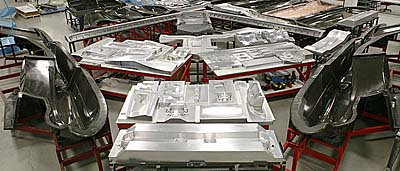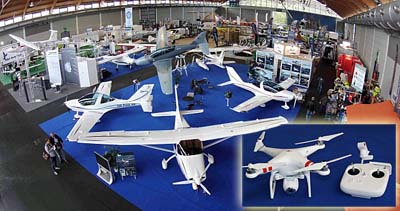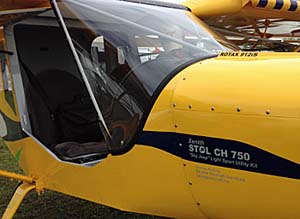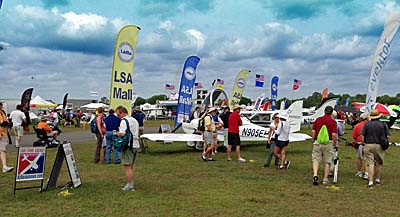 “After a long winter and spring dodging the Utah weather,” SkyCraft Airplanes announced that their SD-1 Minisport, “has completed flight testing successfully, meeting all the performance requirements needed for SLSA Certification.” The Orem, Utah company reported, “The plane was found to have good longitudinal and latitudinal stability and exhibited no issues with flutter, vibrations, or dangerous stall/spin tendencies.” SkyCraft representatives said they were able to verify the performance specifications for the SD-1 achieved by its Czech designers (see video below for a performance hint using a European aircraft). SkyCraft said that following the flight test regimen, they posted updated specifications on the Minisport page.
Minisport has been flying in Europe since 2007 when the airplane and company were created by designer Igor Spacek. The U.S. team first contemplated a kit aircraft — SD-1 Minisport is constructed significantly of wood making it a great project for some craftsmen — but later elected to go the fully-built Special LSA route.
“After a long winter and spring dodging the Utah weather,” SkyCraft Airplanes announced that their SD-1 Minisport, “has completed flight testing successfully, meeting all the performance requirements needed for SLSA Certification.” The Orem, Utah company reported, “The plane was found to have good longitudinal and latitudinal stability and exhibited no issues with flutter, vibrations, or dangerous stall/spin tendencies.” SkyCraft representatives said they were able to verify the performance specifications for the SD-1 achieved by its Czech designers (see video below for a performance hint using a European aircraft). SkyCraft said that following the flight test regimen, they posted updated specifications on the Minisport page.
Minisport has been flying in Europe since 2007 when the airplane and company were created by designer Igor Spacek. The U.S. team first contemplated a kit aircraft — SD-1 Minisport is constructed significantly of wood making it a great project for some craftsmen — but later elected to go the fully-built Special LSA route.SkyCraft Completes Flight Testing of Minisport LSA


Shown in flight is the SD-1 Minisport. While the U.S. team works through the ASTM standards compliance process we present this photo of the Czech manufacturer’s version. SD-1 Minisport was created by designer Igor Spacek.

We’ve followed SkyCraft’s Minisport in earlier articles and will keep our eye on this handsome, affordable single seat SLSA candidate. It is available in either tricycle gear or taildragger configuration.
“After a long winter and spring dodging the Utah weather,” SkyCraft Airplanes announced that their SD-1 Minisport, “has completed flight testing successfully, meeting all the performance requirements needed for SLSA Certification.” The Orem, Utah company reported, “The plane was found to have good longitudinal and latitudinal stability and exhibited no issues with flutter, vibrations, or dangerous stall/spin tendencies.” SkyCraft representatives said they were able to verify the performance specifications for the SD-1 achieved by its Czech designers (see video below for a performance hint using a European aircraft). SkyCraft said that following the flight test regimen, they posted updated specifications on the Minisport page.
Minisport has been flying in Europe since 2007 when the airplane and company were created by designer Igor Spacek. The U.S. team first contemplated a kit aircraft — SD-1 Minisport is constructed significantly of wood making it a great project for some craftsmen — but later elected to go the fully-built Special LSA route. One part of meeting ASTM’s comprehensive standards set is flight testing. “In addition to ensuring the aircraft’s compliance with ASTM standards,” said SkyCraft’s Director of Marketing Paul Glavin, “the flight test program focused on the pilot experience of flying the SD-1 Minisport.” After completing the series, he added, “Based on flight testing reports, SkyCraft will be updating the interior layout of the aircraft prior to delivery to customers.” The U.S. team preparing Minisport uses the same engine as the Czech group. SD-1 is powered by Hirth’s F-23 engine that produces 50 horsepower and boasts dual ignition, fuel injection, and a 1,000 hour time between overhaul. (Watch our video review of Hirth’s engine line.) SD-1 Minisport is available in either tailwheel or tricycle gear configurations.
“The most significant change will be the elimination of the MGL gauges for a more fully integrated Dynon setup,” observed SkyCraft. “This cleaner instrument panel will make the SD-1 more user-friendly and will also allow the aircraft to take advantage of more of the Dynon glass cockpit capabilities.” Reps noted that they believe this change makes the airplane safer since the Dynon SkyView is backed up with a two-hour emergency power supply. “SkyCraft is committed to delivering a safe, comfortable, and fun flying experience, and we are now fully confident that the SD-1 Minisport provides exactly this,” added Glavin. “Completion of flight testing is a significant achievement in SkyCraft’s ultimate goal of certifying the SD-1 Minisport as a SLSA aircraft. With the performance, design, and production of the SD-1 all ASTM-compliant, SkyCraft is very close to achieving its goal.” We plan to follow SkyCraft closely, partly due to the airplane’s very affordable price at less than $60,000 and because it is a rare single seat entry.
Keeping in mind that what you will be watching is the European version rather than the SkyCraft U.S. version, the following video gives you some idea how well the SD-1 Minisport performs on its 50 horsepower Hirth engine.
 “After a long winter and spring dodging the Utah weather,” SkyCraft Airplanes announced that their SD-1 Minisport, “has completed flight testing successfully, meeting all the performance requirements needed for SLSA Certification.” The Orem, Utah company reported, “The plane was found to have good longitudinal and latitudinal stability and exhibited no issues with flutter, vibrations, or dangerous stall/spin tendencies.” SkyCraft representatives said they were able to verify the performance specifications for the SD-1 achieved by its Czech designers (see video below for a performance hint using a European aircraft). SkyCraft said that following the flight test regimen, they posted updated specifications on the Minisport page.
Minisport has been flying in Europe since 2007 when the airplane and company were created by designer Igor Spacek. The U.S. team first contemplated a kit aircraft — SD-1 Minisport is constructed significantly of wood making it a great project for some craftsmen — but later elected to go the fully-built Special LSA route.
“After a long winter and spring dodging the Utah weather,” SkyCraft Airplanes announced that their SD-1 Minisport, “has completed flight testing successfully, meeting all the performance requirements needed for SLSA Certification.” The Orem, Utah company reported, “The plane was found to have good longitudinal and latitudinal stability and exhibited no issues with flutter, vibrations, or dangerous stall/spin tendencies.” SkyCraft representatives said they were able to verify the performance specifications for the SD-1 achieved by its Czech designers (see video below for a performance hint using a European aircraft). SkyCraft said that following the flight test regimen, they posted updated specifications on the Minisport page.
Minisport has been flying in Europe since 2007 when the airplane and company were created by designer Igor Spacek. The U.S. team first contemplated a kit aircraft — SD-1 Minisport is constructed significantly of wood making it a great project for some craftsmen — but later elected to go the fully-built Special LSA route.

 Twenty five years ago the world celebrated a major event in human history: the tearing down of the hated Berlin wall. That was 1989 and the same year brought forth another great occurrence in human freedom (for a completely different reason). That year, Rotax Aircraft Engines introduced their then-brand-new Rotax 912 … or 9-series as some call it. While the Berlin wall allowed Germans to cross a line forbidden for many years, the 912 powerplant gave pilots the freedom to fly with greater confidence. In evidence, several around-the-world flights have been achieved with this popular engine. Today,
Twenty five years ago the world celebrated a major event in human history: the tearing down of the hated Berlin wall. That was 1989 and the same year brought forth another great occurrence in human freedom (for a completely different reason). That year, Rotax Aircraft Engines introduced their then-brand-new Rotax 912 … or 9-series as some call it. While the Berlin wall allowed Germans to cross a line forbidden for many years, the 912 powerplant gave pilots the freedom to fly with greater confidence. In evidence, several around-the-world flights have been achieved with this popular engine. Today, 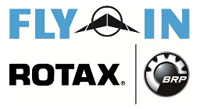 To properly celebrate the 25th anniversary of the 9-series and production of 50,000 912 & 914 engines, Rotax BRP will host a
To properly celebrate the 25th anniversary of the 9-series and production of 50,000 912 & 914 engines, Rotax BRP will host a  Weisse Moewe airfield, home of the local aero club, is where Rotax engineers and test pilots regularly put their engines through real-life tests. Rotax’s 912 is a significant departure from earlier aircraft engines. It is physically smaller, uses liquid cooling, an electronic control unit, and a gearbox to change engine revolutions from 5,000 rpm to slower speeds that work for props. The 912 enjoys a much better power-to-weight ratio than old stand-bys like the Lycoming O-233. That veteran engine produces 100 horsepower (at 2300 rpm; higher power is available at increased revolutions) using 233 cubic inches of cylinder displacement. In a sharp comparison Rotax’s 912 ULS makes the same horsepower using only one-third the displacement, 83 cubic inches. Announced earlier in 2014, the 912 iS Sport takes the 9-series engines to its highest operating and performing plateau. This innovative powerplant is why Rotax won an award from EAA last year and from Aerokurier magazine this year (photo).
Weisse Moewe airfield, home of the local aero club, is where Rotax engineers and test pilots regularly put their engines through real-life tests. Rotax’s 912 is a significant departure from earlier aircraft engines. It is physically smaller, uses liquid cooling, an electronic control unit, and a gearbox to change engine revolutions from 5,000 rpm to slower speeds that work for props. The 912 enjoys a much better power-to-weight ratio than old stand-bys like the Lycoming O-233. That veteran engine produces 100 horsepower (at 2300 rpm; higher power is available at increased revolutions) using 233 cubic inches of cylinder displacement. In a sharp comparison Rotax’s 912 ULS makes the same horsepower using only one-third the displacement, 83 cubic inches. Announced earlier in 2014, the 912 iS Sport takes the 9-series engines to its highest operating and performing plateau. This innovative powerplant is why Rotax won an award from EAA last year and from Aerokurier magazine this year (photo). Since 1973 Rotax has delivered more than seven million engines to a wide range of vehicles. In the aviation sphere, Rotax is celebrating delivery of the 50,000th powerplant in the 9-series. Counting all engines ever produced for aircraft, Rotax has delivered more than 170,000 units. Complementing the Rotax Aircraft Engine line, BRP Powertrain also supplies such well known brands as Ski-Doo and Lynx snowmobiles, Sea-Doo watercraft, Evinrude and Johnson outboard engines, plus Can-Am off-road vehicles and on-road motorcycles.
Since 1973 Rotax has delivered more than seven million engines to a wide range of vehicles. In the aviation sphere, Rotax is celebrating delivery of the 50,000th powerplant in the 9-series. Counting all engines ever produced for aircraft, Rotax has delivered more than 170,000 units. Complementing the Rotax Aircraft Engine line, BRP Powertrain also supplies such well known brands as Ski-Doo and Lynx snowmobiles, Sea-Doo watercraft, Evinrude and Johnson outboard engines, plus Can-Am off-road vehicles and on-road motorcycles.







 “The first Zenith kit aircraft in North America to fly with the new Rotax 912iS engine was a collaborative effort involving Zenith Aircraft Co., which supplied the aircraft kit, Rotech Research Canada, Ltd. which installed the engine, and Skytek Aircraft Services which assembled the airframe,” reported the company. They added that Skytek developed the firewall-forward package for completing the engine installation. “Both the aircraft and the engine performed flawlessly,” said Sebastien Heinz, President of Zenith Aircraft. “We put 7.5 hours on the CH 750 on the first day and had no squawks. Rotax has done it right.”
“The first Zenith kit aircraft in North America to fly with the new Rotax 912iS engine was a collaborative effort involving Zenith Aircraft Co., which supplied the aircraft kit, Rotech Research Canada, Ltd. which installed the engine, and Skytek Aircraft Services which assembled the airframe,” reported the company. They added that Skytek developed the firewall-forward package for completing the engine installation. “Both the aircraft and the engine performed flawlessly,” said Sebastien Heinz, President of Zenith Aircraft. “We put 7.5 hours on the CH 750 on the first day and had no squawks. Rotax has done it right.”  Zenith said installing the fuel-injected 912iS was more complicated than a standard, carbureted 912ULS engine. “However,” Zenith added, “the new model has considerably more redundancy, increased efficiency, reduced pilot workload and is certifiable. It operates without primers, carb heat, or mixture controls.” The engine and accessories are monitored constantly by a built-in computer that alerts pilots to any issues that arise on the ground or in the air. The result is a higher level of reliability and enhanced safety. The Rotax 912iS is a four-cylinder, four-stroke engine with opposed cylinders that is cooled by air and liquid. A dry sump features lubrication from a separate 0.8-gallon oil tank. Hydraulic valve tappets provide automatic adjustment. The 912 iS provides two redundant electronic fuel injection systems, an engine management system, dual electronic ignition, electric starter and an integrated reduction gear. TBO (Time Before Overhaul) is 2,000 hours.
Zenith said installing the fuel-injected 912iS was more complicated than a standard, carbureted 912ULS engine. “However,” Zenith added, “the new model has considerably more redundancy, increased efficiency, reduced pilot workload and is certifiable. It operates without primers, carb heat, or mixture controls.” The engine and accessories are monitored constantly by a built-in computer that alerts pilots to any issues that arise on the ground or in the air. The result is a higher level of reliability and enhanced safety. The Rotax 912iS is a four-cylinder, four-stroke engine with opposed cylinders that is cooled by air and liquid. A dry sump features lubrication from a separate 0.8-gallon oil tank. Hydraulic valve tappets provide automatic adjustment. The 912 iS provides two redundant electronic fuel injection systems, an engine management system, dual electronic ignition, electric starter and an integrated reduction gear. TBO (Time Before Overhaul) is 2,000 hours.




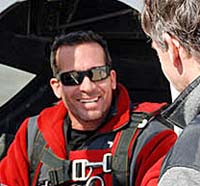





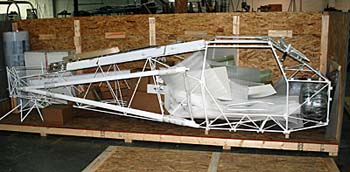


 Electric aircraft continue to be a Euro focus and are now joined by “multicopters” / “drones” / “UAVs” …call them what you will.
Electric aircraft continue to be a Euro focus and are now joined by “multicopters” / “drones” / “UAVs” …call them what you will. In the USA, you can buy the
In the USA, you can buy the  One of my personal delights is the lightest aircraft flown solo. I find an essential magic to flight when the aircraft is particularly lightweight.
One of my personal delights is the lightest aircraft flown solo. I find an essential magic to flight when the aircraft is particularly lightweight. I referred earlier to the
I referred earlier to the 
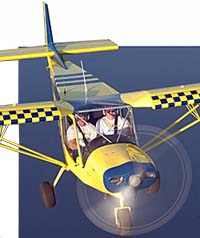




 Once upon a time, a couple years before the SP/LSA was announced at AirVenture 2004, I thought the odds were high that Quicksilver would be the very first Special LSA to hit the market. Several other industry veterans agreed. Their GT500 was the very first to earn FAA’s Primary Category approval, back in 1993. This was a costlier effort than achieving ASTM compliance and so it seemed a done deal that Quicksilver would gain quick approval. I was wrong. Indeed, I was wrong by a dozen years. However, that’s over now as the Temecula, California company earned FAA acceptance for their Sport 2S side-by-side open-cockpit aircraft. In mid-April, FAA sent a letter saying all was well and the company can go forward with manufacturing. With their approval earned, Quicksilver’s S2SE is number 135 on our
Once upon a time, a couple years before the SP/LSA was announced at AirVenture 2004, I thought the odds were high that Quicksilver would be the very first Special LSA to hit the market. Several other industry veterans agreed. Their GT500 was the very first to earn FAA’s Primary Category approval, back in 1993. This was a costlier effort than achieving ASTM compliance and so it seemed a done deal that Quicksilver would gain quick approval. I was wrong. Indeed, I was wrong by a dozen years. However, that’s over now as the Temecula, California company earned FAA acceptance for their Sport 2S side-by-side open-cockpit aircraft. In mid-April, FAA sent a letter saying all was well and the company can go forward with manufacturing. With their approval earned, Quicksilver’s S2SE is number 135 on our  Will Escutia, president of
Will Escutia, president of 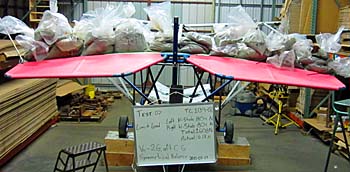 “Furthermore, we plan to start offering ELSA kits in the $33-34,000 range,” added Escutia. Therefore a customer who wants a Sport 2S but does not want to build it has a less expensive alternative and the ELSA version is more attractive to Quicksilver dealers as they can legally charge for assembling them. Escutia indicated that the S2SE Special LSA will be offered with wing coverings in exclusive color patterns that will not be available for kit-built airplanes. “The ELSA kits will be offered with a different design from the SLSA and the EAB kits as well, so people can identify readily if an airplane is an SLSA, an ELSA or a 51% kit (although I understand that later the customer may want to change sail sets),” added Escutia. Quicksilver’s new S2SE is supplied with the 65 horsepower Rotax 582 engine propelling a three-blade 72-inch composite prop. Besides strut braced wings (other models use wire bracing), Sport 2S in SLSA form has beefy landing gear, hydraulic brakes, and full suite of engine and flight instruments. Retail rice is $39,999, an introductory offer good to July 4th, 2014.
“Furthermore, we plan to start offering ELSA kits in the $33-34,000 range,” added Escutia. Therefore a customer who wants a Sport 2S but does not want to build it has a less expensive alternative and the ELSA version is more attractive to Quicksilver dealers as they can legally charge for assembling them. Escutia indicated that the S2SE Special LSA will be offered with wing coverings in exclusive color patterns that will not be available for kit-built airplanes. “The ELSA kits will be offered with a different design from the SLSA and the EAB kits as well, so people can identify readily if an airplane is an SLSA, an ELSA or a 51% kit (although I understand that later the customer may want to change sail sets),” added Escutia. Quicksilver’s new S2SE is supplied with the 65 horsepower Rotax 582 engine propelling a three-blade 72-inch composite prop. Besides strut braced wings (other models use wire bracing), Sport 2S in SLSA form has beefy landing gear, hydraulic brakes, and full suite of engine and flight instruments. Retail rice is $39,999, an introductory offer good to July 4th, 2014. So, I’m pleased that Quicksilver’s new owners took the time — and spent the money — to achieve SLSA status for their iconic Sport 2S model. Yet what I consider equally important is the manufacturing system, specifically the remote locations to that purpose. The LSA industry has a few companies that offer the full range of 51% kits, ELSA kits and SLSA ready-to-fly aircraft. One noteworthy company uses a remote manufacturing location. This is Van’s Aircraft whose RV-12 is assembled by
So, I’m pleased that Quicksilver’s new owners took the time — and spent the money — to achieve SLSA status for their iconic Sport 2S model. Yet what I consider equally important is the manufacturing system, specifically the remote locations to that purpose. The LSA industry has a few companies that offer the full range of 51% kits, ELSA kits and SLSA ready-to-fly aircraft. One noteworthy company uses a remote manufacturing location. This is Van’s Aircraft whose RV-12 is assembled by  “Almost every kid has dreamed of flying. Practical considerations — prices, regulations, safety, etc. — crush this dream for most,” observed Escutia. “Therefore our mission is to become the bridge that allows the aviation enthusiast to fulfill the dream of flying his or her own airplane.” At less than $40,000 for a ready-to-fly version of a highly-proven aircraft, he has a point. Kits can reduce this further. With the remote manufacturing locations, shipping charges will be less so, overall, costs are being significantly restrained. We don’t see enough of that in aviation and I say, “Good for you, Quicksilver!” I wish them luck and urge those readers with no familiarity with the company’s aircraft to give one a flight. They are certain smile-makers.
“Almost every kid has dreamed of flying. Practical considerations — prices, regulations, safety, etc. — crush this dream for most,” observed Escutia. “Therefore our mission is to become the bridge that allows the aviation enthusiast to fulfill the dream of flying his or her own airplane.” At less than $40,000 for a ready-to-fly version of a highly-proven aircraft, he has a point. Kits can reduce this further. With the remote manufacturing locations, shipping charges will be less so, overall, costs are being significantly restrained. We don’t see enough of that in aviation and I say, “Good for you, Quicksilver!” I wish them luck and urge those readers with no familiarity with the company’s aircraft to give one a flight. They are certain smile-makers.
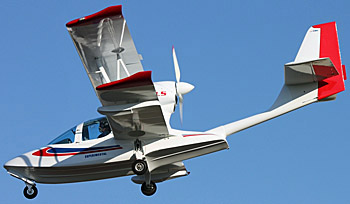 Winter has finally released its icy grip on the northern states that were so punished over the past few months. Here in the “Sunshine State” of Florida, it feels like summer. So what do pilots do in the summertime, in Florida? Go fly seaplanes, of course? What else? Indeed, quite a flock of seaplanes and floatplanes converged on the central Florida city of Tavares, about 45 minutes driving time northwest of Orlando. Appropriately, the area is known as “lakes district” for all the bodies of water. City leaders portray the Tavares as “America’s Seaplane City” and to reinforce that, they have developed their lakefront to include a very welcoming seaplane base with bigger plans underway. On Saturday, April 26th more than 40 seaplanes flew in for the event. One of those was Edra Aeronautica’s Super Petrel LS, one of the newest Special LSA in the fleet. My friend and Spruce Creek Fly-in neighbor, Brian Boucher, is the North American representative for this interesting seaplane and I finally got my first flight in it.
Winter has finally released its icy grip on the northern states that were so punished over the past few months. Here in the “Sunshine State” of Florida, it feels like summer. So what do pilots do in the summertime, in Florida? Go fly seaplanes, of course? What else? Indeed, quite a flock of seaplanes and floatplanes converged on the central Florida city of Tavares, about 45 minutes driving time northwest of Orlando. Appropriately, the area is known as “lakes district” for all the bodies of water. City leaders portray the Tavares as “America’s Seaplane City” and to reinforce that, they have developed their lakefront to include a very welcoming seaplane base with bigger plans underway. On Saturday, April 26th more than 40 seaplanes flew in for the event. One of those was Edra Aeronautica’s Super Petrel LS, one of the newest Special LSA in the fleet. My friend and Spruce Creek Fly-in neighbor, Brian Boucher, is the North American representative for this interesting seaplane and I finally got my first flight in it. Super Petrel LS is a design said to be in its fifth generation. Indeed, I know of the model for more than 20 years. When I first discovered the seaplane, it was represented by a Canadian outfit. However, in 1997 aeronautical engineer and pilot Rodrigo Scoda founded
Super Petrel LS is a design said to be in its fifth generation. Indeed, I know of the model for more than 20 years. When I first discovered the seaplane, it was represented by a Canadian outfit. However, in 1997 aeronautical engineer and pilot Rodrigo Scoda founded  Petrel offers a wide cabin like many Light-Sport Aircraft, 45 inches to be specific. Certainly it was roomy for two average-sized fellows like Brian and myself. The seats were exceptionally comfortable, with the seat cushion extending to your knees in a graceful curve that is very supportive. Only the seat back moves, through three positions that you set before entering. Some occupants may need additional cushions for position or comfort and Brian told one fellow he was too tall to fit; the man said he stood 6 foot 6 inches. The doors swing 180 degrees forward (photo) and can be removed for flying off land, which I would absolutely do … being an old ultralight enthusiast. For choppy water operations, you’ll probably want to keep them on as Super Petrel sits low in the water. However, the airplane also has a bilge pump if some water splashes in during takeoff. Indeed, the older version had only a summer windscreen and not a full enclosure. To accommodate moisture, Petrel’s floor is hard surface. Brian’s present Super Petrel has a mostly analog panel using a removable Garmin Aera for GPS and other digital functions. However, new models coming in will use Dynon’s SkyView and can be configured in various ways. Although the model can handle 55 pounds of luggage, space to stow such gear is limited; fortunately, sport seaplanes are rarely used for long cross country flights where you need extra luggage.
Petrel offers a wide cabin like many Light-Sport Aircraft, 45 inches to be specific. Certainly it was roomy for two average-sized fellows like Brian and myself. The seats were exceptionally comfortable, with the seat cushion extending to your knees in a graceful curve that is very supportive. Only the seat back moves, through three positions that you set before entering. Some occupants may need additional cushions for position or comfort and Brian told one fellow he was too tall to fit; the man said he stood 6 foot 6 inches. The doors swing 180 degrees forward (photo) and can be removed for flying off land, which I would absolutely do … being an old ultralight enthusiast. For choppy water operations, you’ll probably want to keep them on as Super Petrel sits low in the water. However, the airplane also has a bilge pump if some water splashes in during takeoff. Indeed, the older version had only a summer windscreen and not a full enclosure. To accommodate moisture, Petrel’s floor is hard surface. Brian’s present Super Petrel has a mostly analog panel using a removable Garmin Aera for GPS and other digital functions. However, new models coming in will use Dynon’s SkyView and can be configured in various ways. Although the model can handle 55 pounds of luggage, space to stow such gear is limited; fortunately, sport seaplanes are rarely used for long cross country flights where you need extra luggage. Let’s cover some basic specifications: Span is just under 29 feet; wing area is 161 square feet; wing loading is 8.2 pounds per square feet; empty weight is 775 pounds, according to the factory, though this depends on what equipment the owner installs; gross weight is not 1,430 pounds as you might expect but 1,320 pounds; useful load is 545 pounds; Fuel capacity is 25 gallons; so, payload with full fuel is 395 pounds; cockpit width is 45 inches; water takeoff run is less than 400 feet, according to published specs; wheel takeoff on hard surface is 260 feet; cruise is about 90 knots; never exceed speed is 114 knots; stall is 35 knots; maximum endurance is five hours.
Let’s cover some basic specifications: Span is just under 29 feet; wing area is 161 square feet; wing loading is 8.2 pounds per square feet; empty weight is 775 pounds, according to the factory, though this depends on what equipment the owner installs; gross weight is not 1,430 pounds as you might expect but 1,320 pounds; useful load is 545 pounds; Fuel capacity is 25 gallons; so, payload with full fuel is 395 pounds; cockpit width is 45 inches; water takeoff run is less than 400 feet, according to published specs; wheel takeoff on hard surface is 260 feet; cruise is about 90 knots; never exceed speed is 114 knots; stall is 35 knots; maximum endurance is five hours. On the ground, Super Petrel exhibits good manners and one great trick. Thanks to a swiveling nosewheel and differential braking operated by heel pads, Brian showed the airplane can turn around on even a narrow taxiway, turning handily within its own wingspan. The airplane is loaded very lightly on the nosewheel facilitating this, but that means you need to consider loading before flight. With one lightweight occupant, a placard tells you how much water ballast to add in a compartment in the nose. A hatch opens to reveal the nosewheel retract cavity and a water tank for such ballasting. With two normal size persons on board this step is not necessary. On the water, Super Petrel was very comfortable. You can whiz around on step like a speedboat and the low wings dip a sponson in the water to keep you level though flight controls also work well. Super Petrel is simple with no flaps and no water rudder. To maneuver on water a modest prop blast over the tailplane directs you amply well. You can swing the doors forward to allow more airflow though you’ll want to keep a hand on them when turning in windier conditions.
On the ground, Super Petrel exhibits good manners and one great trick. Thanks to a swiveling nosewheel and differential braking operated by heel pads, Brian showed the airplane can turn around on even a narrow taxiway, turning handily within its own wingspan. The airplane is loaded very lightly on the nosewheel facilitating this, but that means you need to consider loading before flight. With one lightweight occupant, a placard tells you how much water ballast to add in a compartment in the nose. A hatch opens to reveal the nosewheel retract cavity and a water tank for such ballasting. With two normal size persons on board this step is not necessary. On the water, Super Petrel was very comfortable. You can whiz around on step like a speedboat and the low wings dip a sponson in the water to keep you level though flight controls also work well. Super Petrel is simple with no flaps and no water rudder. To maneuver on water a modest prop blast over the tailplane directs you amply well. You can swing the doors forward to allow more airflow though you’ll want to keep a hand on them when turning in windier conditions. In flight Super Petrel has very cooperative handling with almost no need to use the rudder pedals. I way overused them at first and then realized most of flight controlling is done with the joystick. Stall is very slow and docile, a word that can be fairly used to describe overall handling qualities. Takeoff from land or water involves full power and some back pressure. Landings proved to be easier than expected. Contrary to some seaplanes you flare Super Petrel and meet the water with the nose higher. Porpoising occurs with most seaplanes but Petrel quiets this easily with some back pressure. Done properly, Petrel is easy to land and after only two previous trials my third was smooth. Visibility is very good as you sit forward of the wings and watching for traffic in the air or on the water found no obstructions. Petrel uses the Rotax 912 or 914 but Brian is excited about the potential of the new 912 iS Sport with its higher torque and power output. “That’s a great combination for seaplanes,” he added. Finally, price: Brian’s business,
In flight Super Petrel has very cooperative handling with almost no need to use the rudder pedals. I way overused them at first and then realized most of flight controlling is done with the joystick. Stall is very slow and docile, a word that can be fairly used to describe overall handling qualities. Takeoff from land or water involves full power and some back pressure. Landings proved to be easier than expected. Contrary to some seaplanes you flare Super Petrel and meet the water with the nose higher. Porpoising occurs with most seaplanes but Petrel quiets this easily with some back pressure. Done properly, Petrel is easy to land and after only two previous trials my third was smooth. Visibility is very good as you sit forward of the wings and watching for traffic in the air or on the water found no obstructions. Petrel uses the Rotax 912 or 914 but Brian is excited about the potential of the new 912 iS Sport with its higher torque and power output. “That’s a great combination for seaplanes,” he added. Finally, price: Brian’s business, 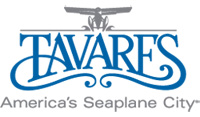 I flew with Brian to the City of
I flew with Brian to the City of 

